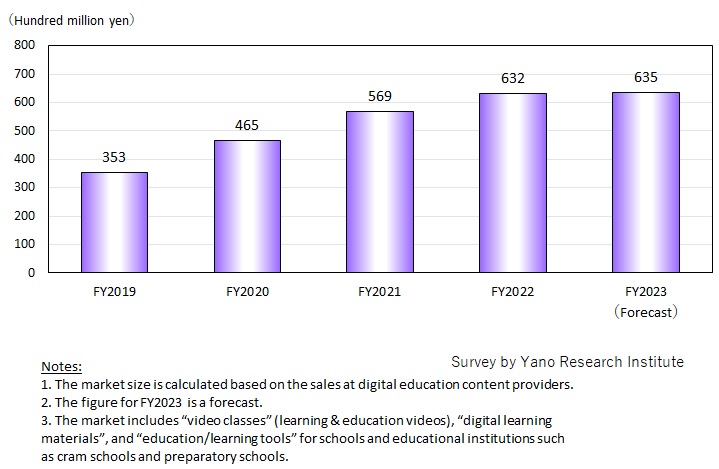No.3288
Digital Education Content Market in Japan: Key Research Findings 2023
FY2022 Digital Education Content Market Grew by 11.1% YoY to 63,200 Million Yen
Yano Research Institute (the President, Takashi Mizukoshi) has carried out a survey on the domestic market of digital education contents, and found out the market trends by field, the trends of market players, and future perspectives.

Market Overview
Size of the digital education content market (as a total of “video classes”, “digital learning materials”, and “education/learning tools”) for FY2022 is forecasted to grow by 11.1% from the previous fiscal year to 63,200 million yen. The “video classes” declined from the preceding fiscal year due to price wars as a result of intensified competition and the rise of new types of college admission system, such as “sogo-senbatsu” and “gakko suisen-senbatsu”, which is stagnating the demand for study materials designed for “ippan-senbatsu”. (*) Meanwhile, growth of the other two fields contributed to the market expansion, against the backdrop of METI’s “EdTech Introduction Subsidy", which lessened the financial burdens of schools to introduce digital learning contents.
As a result of efforts to penetrate digital education as an alternative means for in-person classes during the COVID situation, the digital education contents market has been showing a significant growth since FY2020. Expansion of the market owes particularly to the implementation of GIGA School Plan, which had been moved forward, enabling distribution of PCs to all students in compulsory education, developing ICT environment rapidly at these schools. Meanwhile, "EdTech Introduction Subsidy" by METI for FY2021 and 2022 propelled the demand for digital education contents further. However, although one-computer-per-pupil had been achieved, challenges remain for better utilization of digital education, due to factors such as the difference in the utilization level of ICT by school and the difficulties in securing budget in some municipalities for introduction of digital education software.
*Translator’s note: As per college admission system in Japan, “ippan senbatsu” (general admission) is the most standard, traditional way to enter college, where candidates take admission tests and are selected based on the scores. The relatively new system called “sogo-senbatsu” (comprehensive admission) refers to the selection based on a comprehensive review of a candidate, including high school grades, essays, interviews, etc, while not requiring admission tests. Selection for the “gakko suisen-senbatsu” (school recommendation admission) is based on a recommendation by a designated school, which is mostly done without admission tests (some colleges do).
Noteworthy Topics
Increase of Metaverse Applications in Educational Services
Learning services using metaverse (meaning virtual space; a three-dimensional space on the Internet where avatars are used to perform activities in conditions similar to the real world) started to be used at cram schools and English learning schools around 2020, and the release (start of service) of related services has expanded from 2022 to 2023.
In most cases, these digital learning services are designed to offer communication environment that is equivalent as in in-person classes. Students ‘attend’ classes in the metaverse as avatars, where they can maintain or increase their motivation to learn, through asking questions frankly to teachers/instructors and communicating with each other. The use of avatar also has other advantages, such as encouraging the ‘futoko’ students (meaning children who do not go to school for reasons unrelated to health or finances) to join and helping shy students to communicate with teachers/instructors. Moreover, it may provide unique experiences that are rather difficult to offer in the real world, such as the online visit to World Heritage and performing science experiments that are too dangerous to try in real world. By meeting the needs of learners that wish to take full advantage of these features, content service providers are expected to expand related services.
Future Outlook
The market growth is projected to slow down for FY2023 for several reasons. For one, as there is no “EdTech Introduction Subsidy” for FY2023, local governments and schools with difficulty securing budget have to defer the introduction of software needed for digital education. For another, stagnation is witnessed in the demand for study materials for “ippan-senbatsu”, in line with the major shift in undergraduate admission system. Furthermore, introduction of digital study materials, which boomed during COVID-19 crisis, has been decelerating. Under the circumstances, the digital education content market for FY2023 is forecasted to show marginal growth of 0.5% from the preceding fiscal year to 63,500 million yen.
Research Outline
2.Research Object: Digital education content providers
3.Research Methogology: Face-to-face interviews by our specialized researchers (including online interviews) and literature research
What is the Digital Education Content Market?
The digital education content market in this research indicates “video classes” (learning & education videos), “digital learning materials”, and “education/learning tools” by content providers mainly for schools and educational institutions/corporations that manage cram schools and preparatory schools. The market size is calculated based on the sales of content providers. Nevertheless, digital education contents provided as commercial e-learning material for individual consumers and online courses using web conferencing systems are not included.
<Products and Services in the Market>
Video classes (learning & education videos), digital learning materials, education/learning tools
Published Report
Contact Us
The copyright and all other rights pertaining to this report belong to Yano Research Institute.
Please contact our PR team when quoting the report contents for the purpose other than media coverage.
Depending on the purpose of using our report, we may ask you to present your sentences for confirmation beforehand.